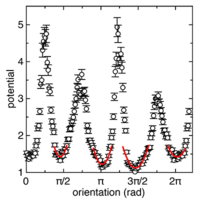当前位置:
X-MOL 学术
›
Phys. Rev. Fluids
›
论文详情
Our official English website, www.x-mol.net, welcomes your feedback! (Note: you will need to create a separate account there.)
Low-dimensional model of the large-scale circulation of turbulent Rayleigh-Bénard convection in a cubic container
Physical Review Fluids ( IF 2.7 ) Pub Date : 2020-06-12 , DOI: 10.1103/physrevfluids.5.064606 Dandan Ji , Eric Brown
Physical Review Fluids ( IF 2.7 ) Pub Date : 2020-06-12 , DOI: 10.1103/physrevfluids.5.064606 Dandan Ji , Eric Brown

|
We test the ability of a low-dimensional turbulence model to predict how dynamics of large-scale coherent structures such as convection rolls change in different cell geometries. The model consists of stochastic ordinary differential equations, which were derived from approximate solutions of the Navier-Stokes equations. We test the model using Rayleigh-Bénard convection experiments in a cubic container, in which there is a single convection roll known as the large-scale circulation (LSC). The model describes the motion of the orientation of the LSC as diffusion in a potential determined by the shape of the cell. The model predicts advected oscillation modes, driven by a restoring force created by the noncircular shape of the cell cross section. We observe the corresponding lowest-wave-number predicted advected oscillation mode in a cubic cell, in which the LSC orientation oscillates around a corner, and a slosh angle rocks back and forth, which is distinct from the higher-wave-number advected twisting and sloshing oscillations found in circular cylindrical cells. Using the Fokker-Planck equation to relate probability distributions of to the potential, we find that the potential has quadratic minima near each corner with the same curvature in both the LSC orientation and slosh angle , as predicted. To quantitatively test the model, we report values of diffusivities and damping timescales for both the LSC orientation and temperature amplitude for the Rayleigh number range . The new oscillation mode around corners is found above a critical . This critical Ra appears in the model as a crossing of an underdamped-overdamped transition. The natural frequency of the potential, oscillation period, power spectrum, and critical Ra for oscillations are consistent with the model if we adjust the model parameters by up to a factor of 2.9, and values are all within a factor of 3 of model predictions. However, these uncertainties in model parameters are too large to correctly predict whether the system is in the underdamped or overdamped state at a given Ra. Since the model was developed for circular cross sections, the success of the model at predicting the potential and its relation to other flow properties for a square cross section—which has different flow modes than the circular cross section—suggests that such a modeling approach could be applied more generally to different cell geometries that support a single convection roll.
中文翻译:

立方容器中湍流瑞利-贝纳德对流的大规模循环的低维模型
我们测试了低维湍流模型预测大型相干结构(例如对流辊)的动力学如何在不同的单元几何中变化的能力。该模型由随机的常微分方程组成,这些方程是从Navier-Stokes方程的近似解导出的。我们在一个立方容器中使用Rayleigh-Bénard对流实验对模型进行测试,在该容器中只有一个对流辊,即大型循环(LSC)。该模型描述了方向运动LSC的扩散是在由细胞形状决定的电位中的扩散。该模型预测由单元横截面的非圆形形状产生的恢复力驱动的对流振荡模式。我们在立方晶胞中观察到相应的最低波数预测平流振荡模式,其中LSC取向 绕拐角和晃动角度摆动 来回摆动,这与在圆柱单元中发现的较高波数平流的扭曲和晃动振荡不同。使用Fokker-Planck方程来关联概率分布 对于电位,我们发现电位在每个角附近在两个LSC方向上都具有相同的曲率的二次极小值 和晃动角度 ,正如预期的那样。为了定量测试模型,我们报告了LSC方向的扩散率和阻尼时标值 和温度幅度(瑞利数范围) 。在关键点上方发现了拐角处的新振荡模式。该临界Ra在模型中显示为欠阻尼过渡过渡的交叉点。如果我们将模型参数最多调整到2.9倍,并且所有值都在模型预测的3倍之内,则振荡的电势,振荡周期,功率谱和临界Ra的固有频率与模型一致。但是,模型参数的这些不确定性太大,无法正确预测给定Ra下系统处于欠阻尼状态还是过阻尼状态。由于该模型是针对圆形横截面开发的,
更新日期:2020-06-12
中文翻译:

立方容器中湍流瑞利-贝纳德对流的大规模循环的低维模型
我们测试了低维湍流模型预测大型相干结构(例如对流辊)的动力学如何在不同的单元几何中变化的能力。该模型由随机的常微分方程组成,这些方程是从Navier-Stokes方程的近似解导出的。我们在一个立方容器中使用Rayleigh-Bénard对流实验对模型进行测试,在该容器中只有一个对流辊,即大型循环(LSC)。该模型描述了方向运动LSC的扩散是在由细胞形状决定的电位中的扩散。该模型预测由单元横截面的非圆形形状产生的恢复力驱动的对流振荡模式。我们在立方晶胞中观察到相应的最低波数预测平流振荡模式,其中LSC取向 绕拐角和晃动角度摆动 来回摆动,这与在圆柱单元中发现的较高波数平流的扭曲和晃动振荡不同。使用Fokker-Planck方程来关联概率分布 对于电位,我们发现电位在每个角附近在两个LSC方向上都具有相同的曲率的二次极小值 和晃动角度 ,正如预期的那样。为了定量测试模型,我们报告了LSC方向的扩散率和阻尼时标值 和温度幅度(瑞利数范围) 。在关键点上方发现了拐角处的新振荡模式。该临界Ra在模型中显示为欠阻尼过渡过渡的交叉点。如果我们将模型参数最多调整到2.9倍,并且所有值都在模型预测的3倍之内,则振荡的电势,振荡周期,功率谱和临界Ra的固有频率与模型一致。但是,模型参数的这些不确定性太大,无法正确预测给定Ra下系统处于欠阻尼状态还是过阻尼状态。由于该模型是针对圆形横截面开发的,



























 京公网安备 11010802027423号
京公网安备 11010802027423号